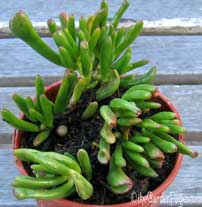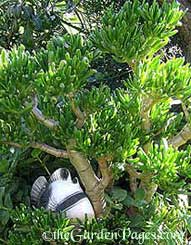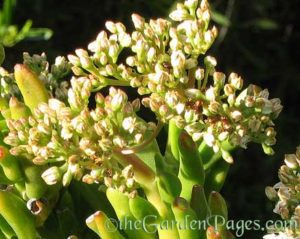
Succulent jade plants are great choices for low water gardens. These plants are easy to grow in hot dry areas and also make great houseplants. Their care is similar to cactus (without the thorns).
One of my favorite succulent plants is named Crassula portulacea, commonly called Horseshoe or Spoon Jade. Recently they’ve been called Shrek Plant, Gollum Fingers, ET Fingers or Hobbit Plant because their dark green leaves look like fingers with reddish tips.
These plants can take full sun to light shade. They are happy indoors as houseplants or outdoors for dry gardens.
These water-wise succulent plants like heat and sun whether you grow them indoors, in containers or in the garden. Crassula portulacea succulent plants are just as easy to care for as their cousin, crassula ovata. Both plants can take up to 6 hours of sun a day, have similar growth habits and look interesting grouped together in the garden.
If your jade plants develop yellow or brown spots on the leaves, it is either stress or sunburn. If they are in a pot, try moving the plant to an area with less sun. If they’re outdoors, try giving them a nice soak and they should perk up. During heat waves you might want to try giving them some temporary shade with a shade cloth or umbrella.
Crassula Plants in Containers
In containers, Crassula portulacea will remain small and is often used for bonsai to take to look of old trees or shrubs.
They grow slowly and can be trimmed into the shape of trees with interesting trunks. In the ground they will eventually reach a height of 4 to 5 feet tall.

Older plants take on a unique gnarled look and can add an underwater look to your garden.
Gollum Jade is great if you don’t have time to fuss over a demanding plant. Crassula happily oblige and even produce blooms in late winter. This increases their value as a landscape plant in my book as winter blooming plants are uncommon.
Shrek Plants produce flower clusters that look like tiny bouquets of daisies. Bloom color can range from light to dark pink, some have a salmon or coral tint. The plant I started as a small cutting two years ago is blooming for the first time this year. Established plants should bloom reliably each year.
These shrubs are called succulent plants because they store their water in their trunks and leaves. This allows them to get by with little water. All that stored water can make them susceptible to rot if they sit in a pool of wet dirt. Let the soil dry out between watering to keep them happy.
Crassula Plant Problems
Rot will show up as warped trunks, sometimes with bubbles on them. The mushy insides eventually dissolves, leaving a brown outer crust. This material will not come back, so throw it on the compost pile.
Drought-tolerant Crassula are best grown in USDA Zones 9b – 11. Every year, mine are able to take a light frost for a few hours. But I’d give them overhead protection in winter if you are in a cold area.
Light frost damage will show up as tiny brown spots, kind of like freckles or scabs. Although unattractive, your plant should be fine, but the spots won’t go away. Sometimes entire leaves will freeze and fall off.
A bad case of frost damage will freeze the plant solid, when it thaws it looks mushy and soft, like rot. Anything that is still solid should come back. Take off the green mush and toss that into the compost pile. Any parts of the plant that are not mushy and are still green have to potential to resprout. Just resist the temptation to water them!

Xeriscaping with drought tolerant cactus and succulents has become popular out here in the southwest where we sometimes have water rationing and shortages.
The unusual shape of Crassula Portulacea plants add a dramatic touch to your landscape and are an easy and reliable addition to any water-wise garden.
For tips on how to expand your collection of plants with stem or leaf cuttings, visit my Succulent Plant Propagation Page…